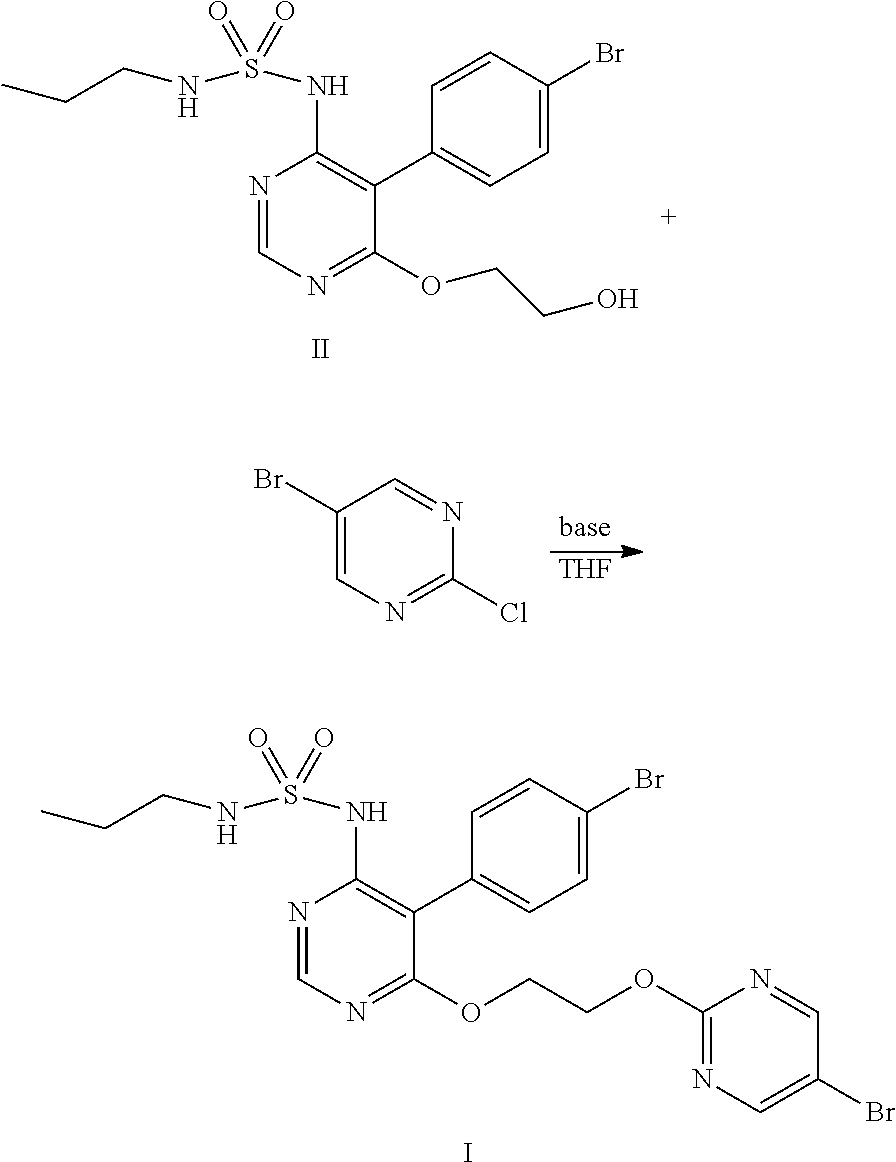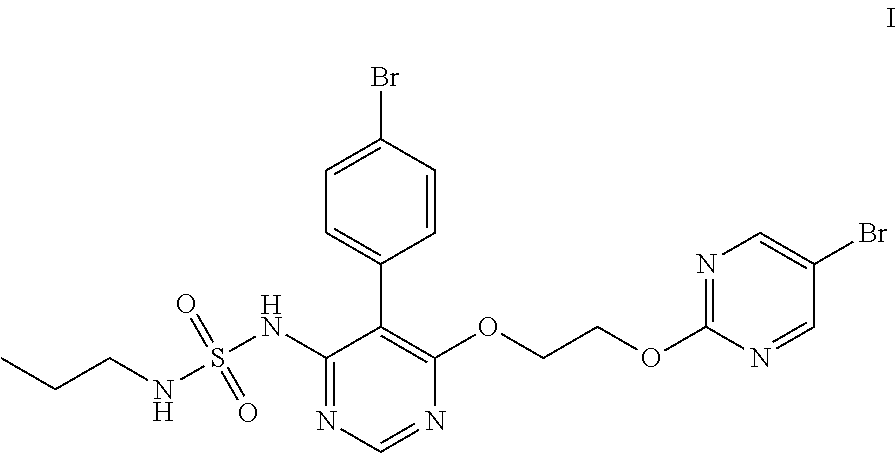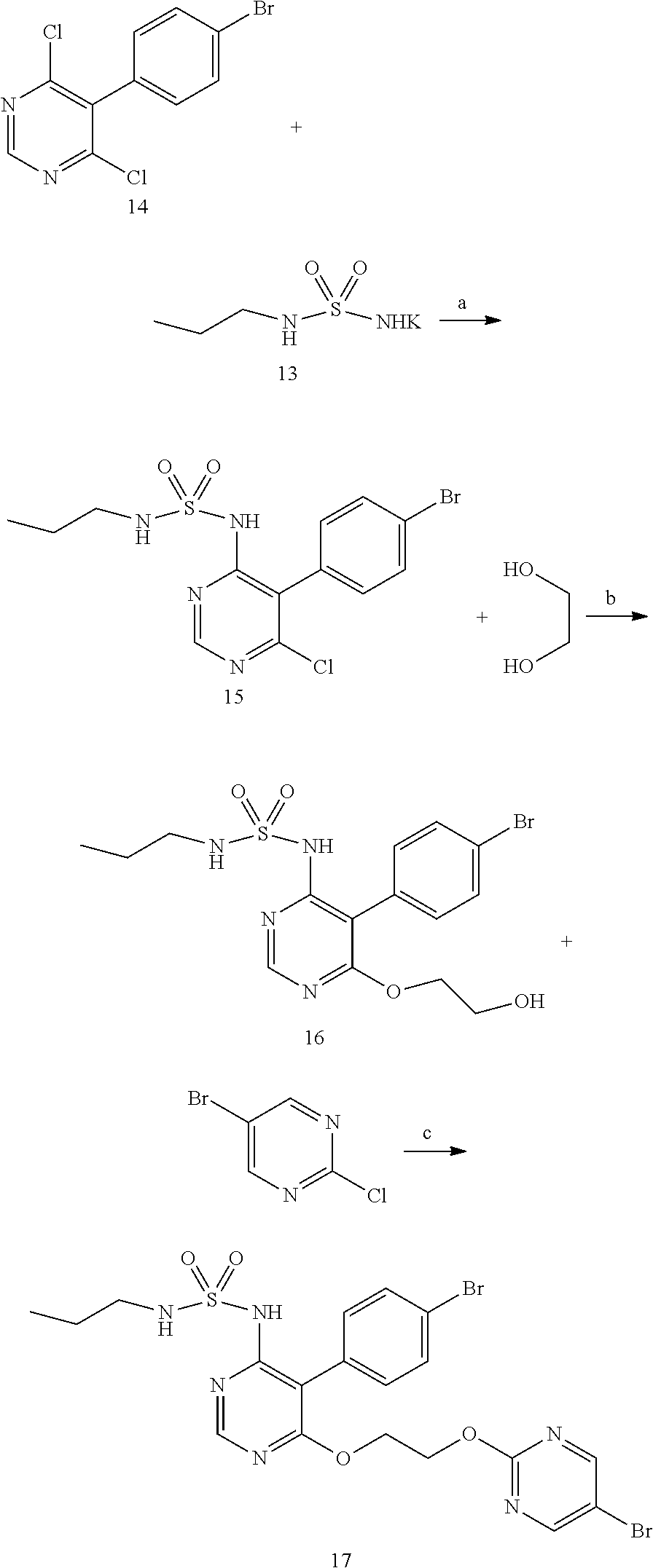Method for preparing macitentan and intermediate compound thereof
a technology of macitentan and intermediate compound, which is applied in the field of chemical synthesis of drugs, can solve the problems of difficult control of the temperature of step c, unsuitable industrial production, and harmful to the environment of solvents, and achieves the effects of reducing the number of steps
- Summary
- Abstract
- Description
- Claims
- Application Information
AI Technical Summary
Benefits of technology
Problems solved by technology
Method used
Image
Examples
example 1
Preparation of Compound III
[0090]608 g (2 mol) of compound IV, 880 g (5 mol) of potassium salt of compound V and 5 L of DMF were added into a 10 L flask. Under the protection of nitrogen, the mixture was heated to 70° C., and reacted at this temperature for 4 hours, then 3.6 L of DMF is recovered by vacuum distillation. Added 3 L of water to residue, adjusted pH value to 6˜7 with hydrochloric acid, then solid participated, filtered and dry to obtain crude solid, recrystallized the crude solid with 2 L of acetonitrile, finally, 700 g of white solid of compound III was obtained, the molar yield was 86%, HPLC purity was 99.7%.
[0091]1HNMR data: 1H NMR (400 MHz, CDCl3): δ8.65 (s, 1H), 7.68-7.74 (m, 2H), 7.16-7.21(m, 2H), 6.90 (s br, 1H), 5.52 (s br, 1H), 2.94-3.03 (m, 2H), 1.50-1.66 (m, 2H), 0.96 (t, J=7.6 Hz, 3H).
example 2
Preparation of Compound II
[0092]40.6 g (0.1 mol) of compound III prepared from Example 1 and 250 ml of ethylene glycol were added into a 2000 ml flask, 65 g of cesium carbonate was added with stirring. Under the protection of nitrogen, the mixture was heated to 130° C., and reacted at this temperature for 5 hours, then cooled to below 50° C. Added 300 ml of water and 300 ml of ethyl acetate to the flask, adjusted pH value to 2˜3 with hydrochloric acid, layered, washed the organic phase with 100 ml of water, then layered again, concentrated the organic phase to obtain the residue. The residue was recrystallized by 300 ml of isopropyl acetate and obtained 38.8 g of compound II. HPLC purity: 99.4%, content of impurity A: 0.15%, content of impurity B: 0.20%, molar yield: 90%.
[0093]1HNMR data: 1H NMR (400 MHz, CDCl3): δ8.48 (s, 1H), 7.61-7.67 (m, 2H), 7.13-7.22 (m, 2H), 5.70 (s br, 1H), 4.47-4.51 (m, 2H), 3.82-3.86 (m, 2H), 2.98 (t, J=7.0 Hz, 2H), 1.50-1.66 (m, 2H), 0.95 (t, J=7.0 Hz, 3H...
example 3
Preparation of Compound II
[0094]40.6 g (0.1 mol) of compound III prepared from Example 1 and 500 ml of ethylene glycol were added into a 2000 ml flask, 98 g of cesium carbonate was added with stirring. Under the protection of nitrogen, the mixture was heated to 110° C., and reacted at this temperature for 4 hours, then cooled to below 50° C. Added 400 ml of water and 300 ml of ethyl acetate to the flask, adjusted pH value to 2˜3 with hydrochloric acid, layered, washed the organic phase with 100 ml of water, then layered again, concentrated the organic phase to obtain the residue. The residue was recrystallized by 300 ml of methanol and obtained 39.6 g of compound II. HPLC purity: 99.5%, content of impurity A: 0.12%, content of impurity B: 0.20%, molar yield: 92%.
[0095]1HNMR data: 1H NMR (400 MHz, CDCl3): δ8.48 (s, 1H), 7.61-7.67 (m, 2H), 7.13-7.22 (m, 2H), 5.70 (s br, 1H), 4.47-4.51 (m, 2H), 3.82-3.86 (m, 2H), 2.98 (t, J=7.0 Hz, 2H), 1.50-1.66 (m, 2H), 0.95 (t, J=7.0 Hz, 3H).
PUM
| Property | Measurement | Unit |
|---|---|---|
| temperature | aaaaa | aaaaa |
| temperature | aaaaa | aaaaa |
| reaction time | aaaaa | aaaaa |
Abstract
Description
Claims
Application Information
 Login to View More
Login to View More - R&D
- Intellectual Property
- Life Sciences
- Materials
- Tech Scout
- Unparalleled Data Quality
- Higher Quality Content
- 60% Fewer Hallucinations
Browse by: Latest US Patents, China's latest patents, Technical Efficacy Thesaurus, Application Domain, Technology Topic, Popular Technical Reports.
© 2025 PatSnap. All rights reserved.Legal|Privacy policy|Modern Slavery Act Transparency Statement|Sitemap|About US| Contact US: help@patsnap.com



